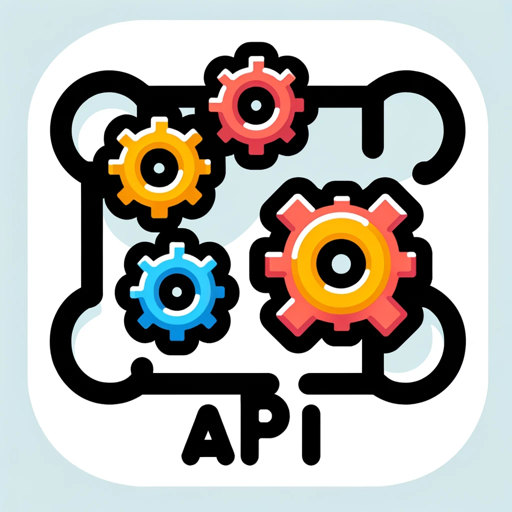Assistant API Builder-AI-powered API Builder
Build and Deploy AI-Powered APIs Effortlessly
Build My Assistant
FAQ's
Related Tools
Load More
OpenAPI Builder
Expert in converting APIs to OpenAPI Schemas, with a focus on education and best practices.

API Builder 👉🏼 OpenAPI Schema
Highly sophisticated and complete agent for generating APIs, perfect for GPT Actions. Can create an OpenAPI schema.

GPT Builder 助手
转换 API 代码为 GPT Schema

API
An API expert, offering technical advice and examples.

API Alchemist
Advanced tool for creating GPT APIs, specialized in code and OpenAPI Schemas.

Assistants API Navigator
Comprehensive guide on OpenAI Assistants API
20.0 / 5 (200 votes)
Introduction to Assistant API Builder
Assistant API Builder is a specialized tool designed to facilitate the creation, deployment, and management of AI-powered assistants using OpenAI's API. Its primary purpose is to streamline the process of building robust, production-ready assistant APIs that can handle a variety of tasks, including natural language processing, code execution, and data retrieval. By leveraging models like GPT-4 and integrating with tools such as code interpreters and knowledge retrieval systems, Assistant API Builder helps developers deploy intelligent assistants that can perform complex functions. For example, an e-commerce platform could use this tool to create a customer support assistant capable of handling order inquiries and providing product recommendations.

Main Functions of Assistant API Builder
Building and Customizing Assistants
Example
Creating a personalized math tutor assistant
Scenario
Developers can define custom instructions and choose specific models (e.g., GPT-4) for their assistants. They can also enable tools like code interpreters to enhance the assistant's capabilities. For instance, a personalized math tutor can be created to solve complex math problems by writing and executing Python code.
Managing Conversations with Threads
Example
Storing and processing user interactions
Scenario
Assistants can manage conversation history using threads, which store messages and handle context length limitations. This is useful in customer support scenarios where an assistant needs to keep track of ongoing issues and provide consistent responses over multiple interactions.
Integrating and Utilizing Tools
Example
Enabling knowledge retrieval for proprietary data
Scenario
Assistants can use tools like knowledge retrieval to access and provide information from proprietary databases or documents. For example, a corporate assistant can retrieve specific details from internal manuals or policy documents to answer employee queries effectively.
Ideal Users of Assistant API Builder
Developers and Technical Teams
Developers and technical teams looking to integrate advanced AI capabilities into their applications will benefit from Assistant API Builder. It offers detailed control over assistant configurations, enabling precise customization for various use cases such as automated customer support, data analysis, and interactive learning environments.
Businesses and Enterprises
Businesses and enterprises that require scalable and intelligent solutions for customer service, employee assistance, and data management can leverage Assistant API Builder to deploy sophisticated assistants. These assistants can handle a wide range of tasks, from answering common customer questions to providing detailed product information, thereby improving operational efficiency and customer satisfaction.

Guidelines for Using Assistant API Builder
Visit aichatonline.org for a free trial without login, also no need for ChatGPT Plus.
Access the platform and start exploring the features and functionalities without any initial setup.
Understand the prerequisites
Ensure you have a basic understanding of APIs, Python, and FastAPI for smooth integration.
Explore common use cases
Familiarize yourself with various use cases such as creating chatbots, integrating with web services, or automating tasks to leverage the tool effectively.
Follow step-by-step guides
Use the provided documentation and tutorials to create, configure, and deploy your own API seamlessly.
Optimize for performance
Regularly review and optimize your API’s performance by monitoring usage, adjusting configurations, and staying updated with the latest features and best practices.
Try other advanced and practical GPTs
Content Marketing GPT
AI-Powered Content Marketing

Icon Genius
AI-Powered iOS Icon Designer
Find My Advisor
AI-powered PhD advisor discovery

Research GPT
AI-powered research for detailed insights

/Imagine Logo
AI-powered logo creation made easy.
Create App Icon
AI-powered app icon creation

Nana (consistent character creation)
AI-Powered Visual Storytelling

CodeGPT
Optimize Your Code with AI.

Social Media Post Crafter
AI-powered tool for social media posts
CraftGPT
AI-Powered Tool for Java and Minecraft Development

English Coach
AI-powered English learning and feedback

Philosophy Master
Unlocking Wisdom with AI

- Education
- Automation
- Integration
- Analytics
- Chatbots
Frequently Asked Questions about Assistant API Builder
What is Assistant API Builder?
Assistant API Builder is a tool designed to help developers create, configure, and deploy APIs using OpenAI's technology, including models like GPT-4.
What are the main features of Assistant API Builder?
The main features include code generation using Python and FastAPI, integration with web services, automated deployment on platforms like Render, and comprehensive documentation for seamless usage.
How do I start using Assistant API Builder?
You can start by visiting aichatonline.org for a free trial without login, understanding the prerequisites, and following the detailed guides provided in the documentation to build and deploy your APIs.
Can I integrate custom tools with Assistant API Builder?
Yes, you can integrate custom tools using the Function calling feature. This allows you to extend the functionality of your APIs by incorporating custom-built tools and functions.
What are some common use cases for Assistant API Builder?
Common use cases include creating chatbots for customer support, automating data analysis tasks, integrating with third-party web services, and developing educational tools for interactive learning.